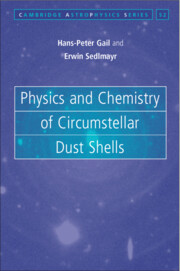2 - Evolutionary Status of Dust-Enshrouded Objects
from Part I - Setting the Stage
Published online by Cambridge University Press: 18 December 2013
Summary
The existence of extended circumstellar dust shells is closely related to the process of mass loss during late stages of stellar evolution, either by strongly enhanced stellar winds or by explosive events. At the same time, products of nuclear burning processes deep in the stellar interior appear at the stellar surface. This changes the element mixture in the visible stellar atmosphere and in the ejected matter compared with the initial stellar composition. The abundance changes due to nucleosynthesis in evolved stars have strong implications for the nature of the condensates that may be formed in the stellar ejecta. For this reason, we start with a brief overview of stellar evolution before considering the dust-formation process in order to clarify which elemental compositions of the ejected material can be expected to exist in dust-forming objects.
Dust formation in nonexplosive events is observed to occur around stars that either are single stars or are members of a wide binary (multiple) system where the presence of the companion(s) does not significantly modify the evolution of the components. Dust formation in close binaries seems to be a rare process because of the hostile conditions for dust formation caused by mass transfer between the components and associated emission of energetic radiation generated by mass infall onto one of the components. The dust-forming late-type stars in binaries seemingly all are members of rather wide systems. Only a very small number of dusty symbiotic stars is known.
- Type
- Chapter
- Information
- Physics and Chemistry of Circumstellar Dust Shells , pp. 29 - 60Publisher: Cambridge University PressPrint publication year: 2013

